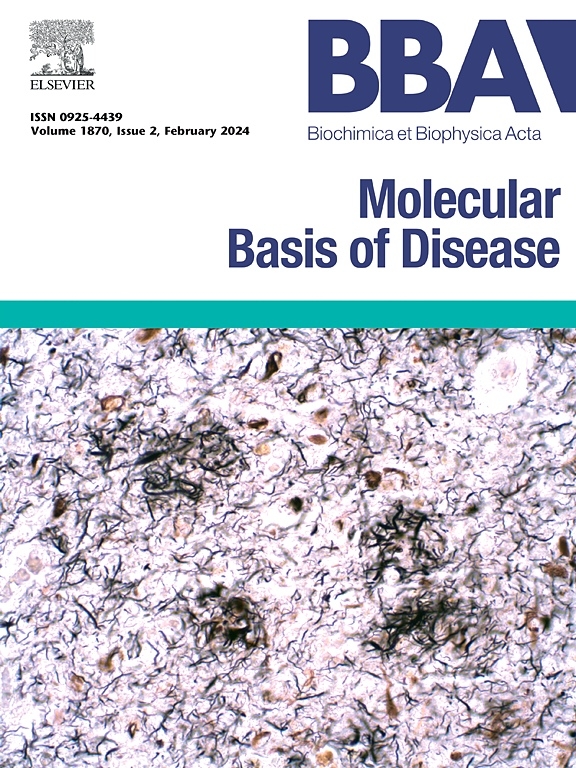Single-cell multi-omics reveals SLC2A1-driven glycolytic reprogramming of pulmonary endothelial cells in sepsis-associated lung injury
IF 4.2
2区 生物学
Q2 BIOCHEMISTRY & MOLECULAR BIOLOGY
Biochimica et biophysica acta. Molecular basis of disease
Pub Date : 2025-09-12
DOI:10.1016/j.bbadis.2025.168050
引用次数: 0
Abstract
Sepsis-induced lung injury is driven by pathological remodeling of pulmonary microvascular endothelial cells (PMVECs), yet the metabolic underpinnings of endothelial dysfunction remain poorly understood. Using single-cell multi-omics analysis of PMVECs from septic patients, we identified profound metabolic reprogramming dominated by glycolysis upregulation, orchestrated through the HIF-1/PI3K-Akt signaling axis. Integrated bioinformatics (Seurat/WGCNA) and experimental validation in a murine sepsis model revealed that SLC2A1-mediated glycolytic flux sustains PMVEC dysfunction, exacerbating tissue inflammation, apoptosis, and fibrosis. Targeted inhibition of glycolysis via SLC2A1 siRNA attenuated metabolic stress, evidenced by reduced extracellular acidification rate (Seahorse) and tricarboxylic acid cycle suppression (metabolomics), while restoring endothelial proliferation, migration, and VEGF/HIF1A homeostasis. Mechanistically, glycolytic inhibition decreased leukocyte infiltration (IHC) and alveolar damage, correlating with improved lung repair metrics. This study establishes PMVEC glycolysis as a keystone of sepsis-associated acute lung injury (ALI), where metabolic reprogramming transitions from adaptive survival signaling to maladaptive tissue injury. Our findings highlight SLC2A1-driven glycolytic pathways as actionable targets for mitigating endothelial dysfunction and advancing metabolic intervention strategies in septic ALI.
单细胞多组学揭示了slc2a1驱动的肺内皮细胞糖酵解重编程在败血症相关肺损伤中的作用。
脓毒症诱导的肺损伤是由肺微血管内皮细胞(PMVECs)的病理性重塑驱动的,然而内皮功能障碍的代谢基础仍然知之甚少。通过对脓毒症患者PMVECs的单细胞多组学分析,我们发现了由糖酵解上调主导的代谢重编程,并通过HIF-1/PI3K-Akt信号轴进行调控。综合生物信息学(Seurat/WGCNA)和小鼠脓毒症模型的实验验证表明,slc2a1介导的糖酵解通量维持PMVEC功能障碍,加剧组织炎症、细胞凋亡和纤维化。通过SLC2A1 siRNA靶向抑制糖酵解可减轻代谢应激,这可以通过降低细胞外酸化率(海马)和三羧酸循环抑制(代谢组学)来证明,同时恢复内皮细胞增殖、迁移和VEGF/HIF1A稳态。机制上,糖酵解抑制降低白细胞浸润(IHC)和肺泡损伤,与改善肺修复指标相关。本研究确定PMVEC糖酵解是脓毒症相关急性肺损伤(ALI)的关键,其中代谢重编程从适应性生存信号转变为适应性不良组织损伤。我们的研究结果强调,slc2a1驱动的糖酵解途径是缓解感染性ALI内皮功能障碍和推进代谢干预策略的可行靶点。
本文章由计算机程序翻译,如有差异,请以英文原文为准。
求助全文
约1分钟内获得全文
求助全文
来源期刊
CiteScore
12.30
自引率
0.00%
发文量
218
审稿时长
32 days
期刊介绍:
BBA Molecular Basis of Disease addresses the biochemistry and molecular genetics of disease processes and models of human disease. This journal covers aspects of aging, cancer, metabolic-, neurological-, and immunological-based disease. Manuscripts focused on using animal models to elucidate biochemical and mechanistic insight in each of these conditions, are particularly encouraged. Manuscripts should emphasize the underlying mechanisms of disease pathways and provide novel contributions to the understanding and/or treatment of these disorders. Highly descriptive and method development submissions may be declined without full review. The submission of uninvited reviews to BBA - Molecular Basis of Disease is strongly discouraged, and any such uninvited review should be accompanied by a coverletter outlining the compelling reasons why the review should be considered.

 求助内容:
求助内容: 应助结果提醒方式:
应助结果提醒方式:


